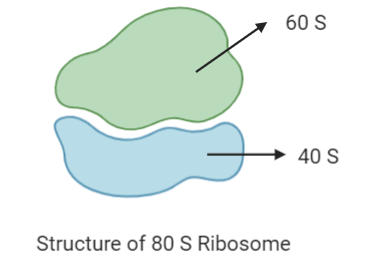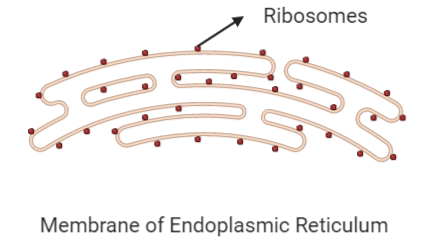
Protein synthesis occurs in an animal cell in
- A. Cytoplasm
B. Cytoplasm as well as mitochondria
C. Ribosomes attached to the nuclear envelope
D. Nucleolus as well as cytoplasm
- A. Cytoplasm
Answer
476.4k+ views
Hint: Protein synthesis takes place during the translation process inside the ribosomes. The ribosome is the protein factory of the cell. Ribosomes are found in both prokaryotic and eukaryotic cells. Ribosomes are also found in association with other cell organelles like mitochondria.
Step by step answer:The process of protein synthesis, known as translation occurs in Ribosomes.

There are two kinds of ribosomes that are present in the organisms. The two kinds of ribosomes are as follows –
70 S – These ribosomes are present in both the prokaryotes and eukaryotes. They are made up of the sub-units of 50 S and 30 S respectively. They are also found over the mitochondria.
80 S – These ribosomes are present only in the eukaryotes. They are made up of the sub-units of 60 S and 40 S respectively.

S stands for the sedimentation coefficient here. These two units remain free and attach only during the process of translation or protein synthesis. In eukaryotic cells, the nucleolus is the factory of the ribosomes. This means that the ribosomes are synthesized in the nucleolus. Also, the ribosomes are found attached to the Endoplasmic Reticulum (ER) or they are found freely present in the cytoplasm.

70 S ribosomes are found in the matrix of the mitochondria of both the prokaryotic and the eukaryotic cells. This is because mitochondria are the powerhouse of the cell and the major site for aerobic respiration and ATP production.

The attached ribosomes are concerned with the synthesis of the secretory proteins. And the free ribosomes are concerned with the synthesis of the non-secretory proteins. Therefore, the ribosomes are found in Cytoplasm, on ER, and in Mitochondria. The ribosome performs protein synthesis so these places will be the site of translation.
Hence option B is correct.
Note: The ribosomes are the smallest cell organelle. They are so small that they cannot be observed under normal microscopes. Thus, we need an electron microscope to observe them.
The ribosomes are also known as the Palade body. This is because it was first observed by ‘Palade’.
Step by step answer:The process of protein synthesis, known as translation occurs in Ribosomes.

There are two kinds of ribosomes that are present in the organisms. The two kinds of ribosomes are as follows –
70 S – These ribosomes are present in both the prokaryotes and eukaryotes. They are made up of the sub-units of 50 S and 30 S respectively. They are also found over the mitochondria.
80 S – These ribosomes are present only in the eukaryotes. They are made up of the sub-units of 60 S and 40 S respectively.

S stands for the sedimentation coefficient here. These two units remain free and attach only during the process of translation or protein synthesis. In eukaryotic cells, the nucleolus is the factory of the ribosomes. This means that the ribosomes are synthesized in the nucleolus. Also, the ribosomes are found attached to the Endoplasmic Reticulum (ER) or they are found freely present in the cytoplasm.

70 S ribosomes are found in the matrix of the mitochondria of both the prokaryotic and the eukaryotic cells. This is because mitochondria are the powerhouse of the cell and the major site for aerobic respiration and ATP production.

The attached ribosomes are concerned with the synthesis of the secretory proteins. And the free ribosomes are concerned with the synthesis of the non-secretory proteins. Therefore, the ribosomes are found in Cytoplasm, on ER, and in Mitochondria. The ribosome performs protein synthesis so these places will be the site of translation.
Hence option B is correct.
Note: The ribosomes are the smallest cell organelle. They are so small that they cannot be observed under normal microscopes. Thus, we need an electron microscope to observe them.
The ribosomes are also known as the Palade body. This is because it was first observed by ‘Palade’.
Recently Updated Pages
Master Class 11 Accountancy: Engaging Questions & Answers for Success

Express the following as a fraction and simplify a class 7 maths CBSE

The length and width of a rectangle are in ratio of class 7 maths CBSE

The ratio of the income to the expenditure of a family class 7 maths CBSE

How do you write 025 million in scientific notatio class 7 maths CBSE

How do you convert 295 meters per second to kilometers class 7 maths CBSE

Trending doubts
Which are the Top 10 Largest Countries of the World?

Differentiate between homogeneous and heterogeneous class 12 chemistry CBSE

What is a transformer Explain the principle construction class 12 physics CBSE

Draw a labelled sketch of the human eye class 12 physics CBSE

What is the Full Form of PVC, PET, HDPE, LDPE, PP and PS ?

How much time does it take to bleed after eating p class 12 biology CBSE




